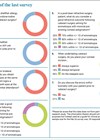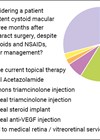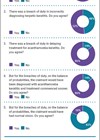
In the first case we were faced with a 55-year-old patient with narrow, potentially occludable drainage angles, no significant cataract, and persistently raised intraocular pressures (IOPs) of 28mmHg with early disc compromise, and normal vision in each eye. It is worth going through the definitions to ensure we are singing from the same hymn sheet when discussing these cases here, and when referring on to colleagues and making management decisions.
- Primary angle closure suspects have clinically occludable angles / iridotrabecular contact in the presence of normal IOP and no evidence of glaucomatous optic neuropathy.
- Primary angle closure patients have clinically occludable angles / iridotrabecular contact with a raised IOP. There is no evidence of glaucomatous optic neuropathy / optic disc is healthy.
- Acute angle closure crisis (not glaucoma yet) occurs when the pressure rises rapidly and results in the familiar physical signs of dilated, unresponsive pupil resulting from iris ischemia, redness and corneal oedema. The patient often experiences visual loss and pain. If optic disc damage is found at this stage it is usually pre-existent and a manifestation of previously raised pressures.
- Primary angle closure glaucoma (PACG) patients have clinically occludable angles / iridotrabecular contact usually with a raised IOP (although IOP can fluctuate) and signs of glaucomatous optic neuropathy.
So, in the case described we have occludable angles, raised IOPs and signs of early glaucomatous optic neuropathy, fulfilling the criteria for PACG.
We need to lower the IOP somehow. Selective laser trabeculoplasty is not appropriate as we have no clear visualisation of the angle structures. In my opinion, definitive management of the IOP needs to be either in the form of lens extraction to open the angle or drop therapy. I do not believe a peripheral iridotomy (PI) will bring the pressure down to an acceptable level. In the end, the decision is not ours but the patients. All options are possible, and we need to give the patient the pros and cons of each strategy. It is likely that the patient is a hyperope and may welcome an excuse to minimise their spectacle dependency. Alternatively, they may be averse to surgery and prefer drops and PI. It is important such discussions are properly documented in the clinical record. More than half of you elected for PI as a first line treatment. We will explore the option of prophylactic PI below.
In our hypothetical patient we elected for lens extraction and placed them on the waiting list. They were left waiting for four months and developed acute angle closure with visual loss – with the pressures on our waiting lists and capacity it is a common scenario. The question was whether there was a case to answer and a breach of duty in not operating on the patient sooner. Three quarters of you felt that there was, a figure which surprised me. It is certain that such cases should not be put down on the ‘routine’ waiting list and need to be done sooner, as they are at greater risk of harm than the ordinary cataract patient. The duty of care is to recognise that and try to expedite definitive surgery to prevent harm, but I am not sure if it is a breach. If there were other ‘soon’ patients on the waiting list and they had equal priority, is it a breach not to push them aside for this patient? Safety netting in this case is also of vital importance.
You all unanimously felt that the harm was avoidable, and I agree, however, that does not necessarily imply a breach of duty. Three quarters of you felt that the delay to surgery was too long and again I agree. There was foreseeable harm and ideally the surgery should have been done sooner if possible. And it is the ‘if possible’ caveat which causes issues. What if it was not possible to do the surgery sooner due to other priority cases, or unexpected sickness? Is that enough of an excuse to absolve the provider?
Question 5 highlights the dilemma that medical experts face. I am often questioned as to when a delay turns from reasonable to not ideal, to undesirable, to unacceptable and a breach of duty. The spread of opinion in response to this question reinforces the fact that it is not an easy question to answer. One quarter of you felt that the procedure needed to be undertaken within two weeks and a third within one month.
Question 6 describes a scenario I commonly see in my medico-legal practice. In this case the patient had to wait for three months for surgery and during this time the pressure went up and caused further damage. Eighty-eight percent of you felt that there was a breach of duty.
Finally, 91% of you felt that a PI was indicated if there was going to be a delay to lens surgery and again, I would tend to agree. However, agreeing that it is a good idea is not the same as asserting it is a breach of duty not to do it. Remember that the practice must not be supported by any responsible body of medical opinion for it to be deemed a breach of duty and our surveys clearly shine a light on the fact that practice does vary.











